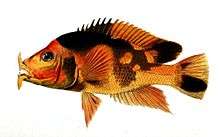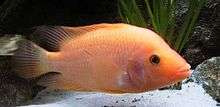Amphilophus labiatus
Amphilophus labiatus is a large cichlid fish endemic to Lake Managua and Lake Nicaragua in Central America. It is also known by the common name red devil cichlid, which it shares with another closely related cichlid, A. citrinellus.
| Amphilophus labiatus | |
|---|---|
 | |
| Scientific classification | |
| Kingdom: | Animalia |
| Phylum: | Chordata |
| Class: | Actinopterygii |
| Order: | Cichliformes |
| Family: | Cichlidae |
| Genus: | Amphilophus |
| Species: | A. labiatus |
| Binomial name | |
| Amphilophus labiatus (Günther, 1864) | |
| Synonyms | |

Description
Colouration in wild specimens is variable and while most specimens are grey to greyish green some pink, red or white specimens do occur. Black pigmentation in spots or bands is also common. Some specimens have enlarged lips, though this condition is thought to be related to specific food choice preferences in their natural habitat as this trait disappears in captivity. Like most cichlids, A. labiatus has advanced brood care. The species forms monogamous pairs which spawn on flattened rocks or logs.
Aquarium
In the aquarium trade A. labiatus is often sold under the trade name of red devil, a common name which they share with Amphilophus citrinellus, which is more correctly known as the Midas Cichlid owing to its yellow coloration. This occasionally causes confusion between customers and companies that sell both A. labiatus and Amphilophus citrinellus.
- Behavior
Aquarists who keep cichlids regard red devils as aggressive fish. This aggressive behavior combined with their razor sharp teeth and powerful jaws means cohabitants should be chosen carefully and the fish should be kept in a large aquarium. Red devils may be so aggressive that they ram into the glass to get at invaders, break heaters and other aquarium equipment, and will sometimes bite their owners.
Invasive spesies
In Indonesia this species was introduced as aquarium ornamental fish. However, it was released to the wild and has become an invasive species, especially in lakes of Java, Sulawesi and Papua.[1]
References
- Media, Kompas Cyber. "Ikan Asing Sumber Kerusakan Keanekaragaman Hayati Indonesia, Mengapa?". KOMPAS.com (in Indonesian). Retrieved 2020-07-14.
- Froese, Rainer and Pauly, Daniel, eds. (2006). "Amphilophus labiatus" in FishBase. July 2006 version.